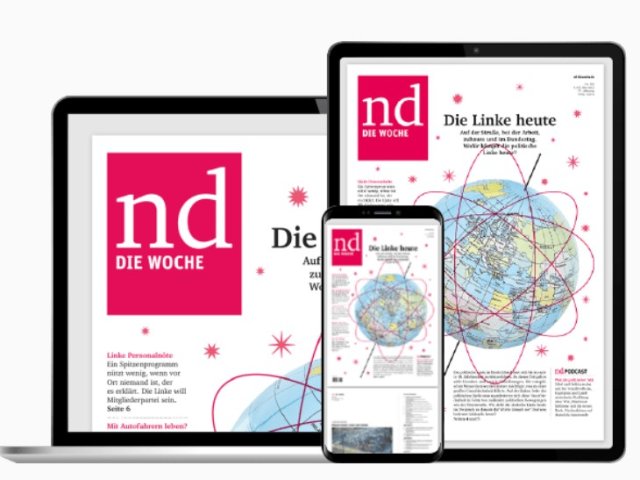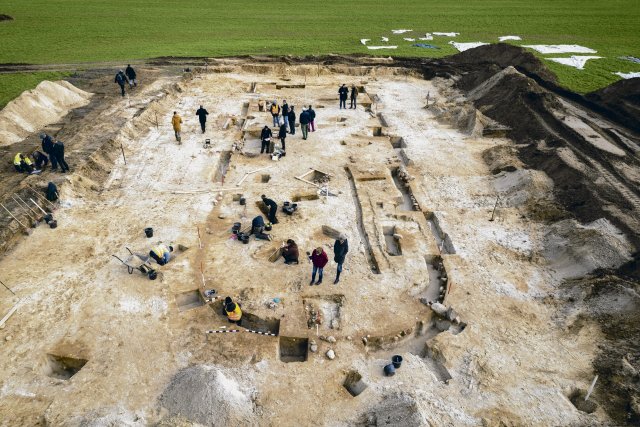The newly discovered floor plan of a large Bronze Age house, possibly an assembly hall, near Seddin.
Photo: BLDAM
Once upon a time, the mighty King Hinz ruled Prignitz. When he died, a unique tomb was built for him and he was placed in three precious coffins: one copper, one silver and, inside, a coffin made of pure gold. His wife and a loyal servant followed him to death. The grave was covered with a huge mound. This legend has been told in Prignitz for a long time. That’s not surprising. Because around Seddin, not far from Perleberg, over 100 hills were noticeable in the 19th century. Since 1850, locals have been digging shafts into the hills in search of treasure or just stone blocks for road construction.
This was also the case on September 15, 1899, when two workers came across a burial chamber in a hill, opened it and found valuable objects. The focus was a clay pot almost 50 centimeters high and closed with a lid. Inside was a double-conical bronze sheet amphora that was filled with the cremation of a 30 to 40-year-old man and several bronze objects (hatchet, knife, cup). In front of it, a bronze sword was stuck in the clay floor with the point pointing upwards. Two clay urns with the burned bones of two young women between the ages of 20 and 30 stood next to it. Three empty clay pots, several bronze objects (drinking bowls, razors, tweezers), two iron needles and necklaces made of bronze wire and glass beads – a total of over 40 objects were given to the three dead. The mound with the valuable goods from the late Bronze Age became famous as the “Royal Tomb of Seddin”. The finds came to the Märkisches Provinzialmuseum Berlin. Some of the objects were lost at the end of the Second World War. The remaining objects ended up in the Museum of Prehistory and Early History in Berlin-Charlottenburg via a detour and in 1999 they returned to the Märkisches Museum Berlin.
Dr. Schmidt explains the world

Stephanie Schoell
As a polymath of the nd editorial team, the science journalist Dr. Steffen Schmidt has an answer to almost every question – and if he doesn’t, he answers another one. All episodes can be listened to on: dasnd.de/schmidt
Remains of a representative hall
The Brandenburg State Office for Monument Preservation (BLDAM) has been researching the grave complex and its surroundings since 2000. And since the beginning of 2023, the German Research Foundation (DFG) has been funding the joint project of the BLDAM and the Seminar for Prehistory and Protohistory at the Georg August University of Göttingen “Settlement Environment Seddin SiSe”. This year’s excavation campaign ended with a huge surprise: 250 meters north of the burial mound, the floor plan of a ten meter wide and 31 meter long building was completely uncovered. Stones lay in the surrounding wall trenches as a base on which the walls made of wooden planks and wattle and daub with clay plaster were placed. A fireplace was discovered in the western half. A small clay vessel found on the north wall could have been placed there as a building sacrifice. C14 analyzes and ceramic remains date the construction and use of the building to the 10th to 9th centuries BC. This means that they are slightly older than the royal grave itself and may also date back to the lifetime of the person later buried there. The multi-story building is the largest hall-shaped building of the Nordic Bronze Age. It could have served as a meeting hall, as a representative center of a large settlement connected to the royal tomb.
But back to the starting point of the archaeological investigations at Seddin, the royal tomb itself. The burial chamber, formed by nine upright stone blocks, is closed at the top with stacked slabs in the form of a false vault. The insides were plastered with clay on which red meander-like motifs were painted. Material analysis has shown that the red color is hematite (red chalk), a pigment that was associated with blood and life in the funerary cults of earlier cultures. The painted burial chamber is, comparable to Bronze Age house buildings, seen as the residence of the dead. In terms of size and construction, the burial chamber is unique in northern Germany.
Multi-layered burial mound
The excavators found a thin layer of sand with fine pieces of charcoal directly above the former surface. This layer may have been created during the consecration of the place or when the dead were burned. Using the C14 radiocarbon method, charcoal was dated to the late 9th century BC. BC, the end of the Late Bronze Age. The burial chamber stands on this layer. A ring of boulders measuring 64 meters in diameter was created around the chamber and the hill was heaped up above it. The hill itself is structured like a “layered cake,” as georadar measurements showed: a layer of sand was covered three times on top of each other with a stone pavement. The surface of the hill, which is now nine meters high, was once covered with stones and gave the impression of a monumental stone structure. “To make power permanently visible and to build for eternity,” says Jens May, archaeologist at BLDAM, summarizing the intentions of the builders.
The rich offerings are also exceptional for a grave from the Late Bronze Age Nordic culture. The amphora decorated with plastic humps aroused particular interest. A similar humpback decoration can also be found on a bronze vessel from Herzberg (Ostprignitz). If you add up the different rows of humps, the sum results in the 354 days of a lunar year, that is, the twelve times the phases of the moon go through, and the 366 days of a solar year, the time when the Earth revolves around the sun. This led to the assumption that both vessels could have served as a calendar. When both vessels were measured with 3D scans at the Dresden State Office for Archeology, the researchers experienced another surprise: both vessels have identical similarities in terms of dimensions, outline shapes and the formation of the humpback decoration. They were probably made in the same workshop or even by the same bronze craftsman.
The grave finds also reveal interesting geographical connections. There are striking parallels for the amphora in an Etruscan noble grave of the Villanova culture in Veii in central Italy. The symbols on the knife and razor, on the other hand, point to similarly rich grave furnishings in Jutland, Schleswig-Holstein and Funen in the Nordic Bronze Age.
In addition to the bronze objects, two rather inconspicuous finds are easily overlooked: two simple needles made of iron. This metal was popular in its extraction and processing in the European North at the end of the 9th century BC. BC still unknown. Material and finished products had to be imported from the south and southeast of Europe. The iron needles from the grave can therefore be viewed as rare and expensive prestige objects, but also point to the approaching transition to the Iron Age.
Search for the settlement structure
But where did the people who built this massive facility live and work? In the fall of 2004, in connection with the laying of a long-distance gas pipeline, the area was searched for archaeological objects using long, narrow excavation trenches. Numerous traces of settlement were found: fireplaces and post holes from house buildings. With the ceramics found, many findings could be dated to the late Bronze Age. The limited study areas did not yet allow reconstructions of the settlement structures.
Since 2015, the research project “Settlement Environment Seddin SiSe” has been investigating the extent and structure of the suspected settlement and its connection to the grave. Geometric measurements documented numerous anomalies in the earth’s magnetic field in the ground, indicating possible traces of settlement. With the help of these measurement images, new excavations were carried out in places with many anomalies, which in turn revealed many new details: hearths and rows of posts of buildings, many cooking pits filled with stones, charcoal and ceramic shards, fence ditches to demarcate individual farms. The remains of the settlement could be dated back to the late 9th century BC. BC can be dated to approximately the same time as the royal grave.
Another archaeological find has not yet provided any information about its function: 150 pits laid out in a straight line were filled with stones the size of a fist or a head. The stones were cracked and chipped as a result of exposure to intense heat. However, there were no fires burning in the pits, which means they were not set up for cooking. The reconstruction also shows that the stones were not poured into the pits, but were carefully stacked close together. C14 data from some small pieces of charcoal show that the construction of the series of stone pits began before the grave was built, but that their continuation and use was still ongoing at the time the grave was built. The complete excavation of some pits showed that an average of 225 kilos of stone material was “used” per grave, which would mathematically mean around 34 tons of stones for the entire series of pits. Even if the function remains a mystery, a connection with ritual actions during the preparation of the burial site and the construction of the grave is conceivable.
A monument from the Bronze Age
The tomb of Seddin was already there when it was built in the years before 800 BC. An “outstanding” monument. In the Late Bronze Age, the importance of long-distance trade across the major rivers – Elbe and Oder, Morava and Danube – increased significantly. Amber from the north, copper and lead from the south and the knowledge of how to process them were exchanged. Seddin was on the southern border of the Nordic Bronze Age culture and established a connection to the Urnfield culture and the Lusatian culture to the south. And it benefited from its favorable location on the once navigable Stepenitz with its direct connection to the Elbe. “King Hinz” is of course not a verifiable title or name. But the oversized grave mound, the two female burials and the valuable grave goods show that the dead man had a prominent social position. And some objects indicate that the ruler of Seddin combined political-military power and priestly-sacral tasks in his person as a “sacred king” or “priest prince”.
The royal grave moved from the Märkisches Museum to the New Museum on Museum Island in 2019. For a few weeks now, the replica of the burial chamber with the goods has been presented there in an elaborate redesign. Archaeologists will continue to uncover new findings in the future when researching the grave, the settlement with its houses and workshops and in the search for the ruler’s seat.
Subscribe to the “nd”

Being left is complicated.
We keep track!
With our digital promotional subscription you can read all issues of »nd« digitally (nd.App or nd.Epaper) for little money at home or on the go.
Subscribe now!
link sbobet demo slot sbobet88
